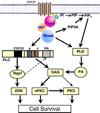Revisited and revised: is RhoA always a villain in cardiac pathophysiology?
- PMID: 20559774
- PMCID: PMC3005405
- DOI: 10.1007/s12265-010-9192-8
Revisited and revised: is RhoA always a villain in cardiac pathophysiology?
Abstract
The neonatal rat ventricular myocyte model of hypertrophy has provided tremendous insight with regard to signaling pathways regulating cardiac growth and gene expression. Many mediators thus discovered have been successfully extrapolated to the in vivo setting, as assessed using genetically engineered mice and physiological interventions. Studies in neonatal rat ventricular myocytes demonstrated a role for the small G-protein RhoA and its downstream effector kinase, Rho-associated coiled-coil containing protein kinase (ROCK), in agonist-mediated hypertrophy. Transgenic expression of RhoA in the heart does not phenocopy this response, however, nor does genetic deletion of ROCK prevent hypertrophy. Pharmacologic inhibition of ROCK has effects most consistent with roles for RhoA signaling in the development of heart failure or responses to ischemic damage. Whether signals elicited downstream of RhoA promote cell death or survival and are deleterious or salutary is, however, context and cell-type dependent. The concepts discussed above are reviewed, and the hypothesis that RhoA might protect cardiomyocytes from ischemia and other insults is presented. Novel RhoA targets including phospholipid regulated and regulating enzymes (Akt, PI kinases, phospholipase C, protein kinases C and D) and serum response element-mediated transcriptional responses are considered as possible pathways through which RhoA could affect cardiomyocyte survival.
Figures




Similar articles
-
Protein Kinase N Promotes Stress-Induced Cardiac Dysfunction Through Phosphorylation of Myocardin-Related Transcription Factor A and Disruption of Its Interaction With Actin.Circulation. 2019 Nov 19;140(21):1737-1752. doi: 10.1161/CIRCULATIONAHA.119.041019. Epub 2019 Sep 30. Circulation. 2019. PMID: 31564129
-
Nitric oxide inhibits endothelin-1-induced neonatal cardiomyocyte hypertrophy via a RhoA-ROCK-dependent pathway.J Mol Cell Cardiol. 2009 Dec;47(6):810-8. doi: 10.1016/j.yjmcc.2009.09.012. Epub 2009 Sep 30. J Mol Cell Cardiol. 2009. PMID: 19799911
-
Ginseng (Panax quinquefolius) attenuates leptin-induced cardiac hypertrophy through inhibition of p115Rho guanine nucleotide exchange factor-RhoA/Rho-associated, coiled-coil containing protein kinase-dependent mitogen-activated protein kinase pathway activation.J Pharmacol Exp Ther. 2011 Dec;339(3):746-56. doi: 10.1124/jpet.111.182600. Epub 2011 Aug 29. J Pharmacol Exp Ther. 2011. PMID: 21875949
-
Rho Kinases and Cardiac Remodeling.Circ J. 2016 Jun 24;80(7):1491-8. doi: 10.1253/circj.CJ-16-0433. Epub 2016 Jun 1. Circ J. 2016. PMID: 27251065 Free PMC article. Review.
-
Untangling the role of RhoA in the heart: protective effect and mechanism.Cell Death Dis. 2024 Aug 9;15(8):579. doi: 10.1038/s41419-024-06928-8. Cell Death Dis. 2024. PMID: 39122698 Free PMC article. Review.
Cited by
-
Crystal structure of mouse RhoA:GTPγS complex in a centered lattice.J Struct Funct Genomics. 2012 Dec;13(4):241-5. doi: 10.1007/s10969-012-9143-5. Epub 2012 Sep 22. J Struct Funct Genomics. 2012. PMID: 23001747
-
RhoA: a dubious molecule in cardiac pathophysiology.J Biomed Sci. 2021 Apr 28;28(1):33. doi: 10.1186/s12929-021-00730-w. J Biomed Sci. 2021. PMID: 33906663 Free PMC article. Review.
-
Distinct roles for ROCK1 and ROCK2 in the regulation of cell detachment.Cell Death Dis. 2013 Feb 7;4(2):e483. doi: 10.1038/cddis.2013.10. Cell Death Dis. 2013. PMID: 23392171 Free PMC article.
-
Roles of small GTPases in cardiac hypertrophy (Review).Mol Med Rep. 2024 Nov;30(5):208. doi: 10.3892/mmr.2024.13332. Epub 2024 Sep 20. Mol Med Rep. 2024. PMID: 39301654 Free PMC article. Review.
-
Depletion of PtdIns(4,5)P₂ underlies retinal degeneration in Drosophila trp mutants.J Cell Sci. 2013 Mar 1;126(Pt 5):1247-59. doi: 10.1242/jcs.120592. Epub 2013 Feb 1. J Cell Sci. 2013. PMID: 23378018 Free PMC article.
References
-
- Shubeita HE, McDonough PM, Harris AN, Knowlton KU, Glembotski CC, Brown JH, et al. Endothelin induction of inositol phospholipid hydrolysis, sarcomere assembly, and cardiac gene expression in ventricular myocytes: a paracrine mechanism for myocardial cell hypertrophy. The Journal of Biological Chemistry. 1990;265:20555. - PubMed
-
- Simpson P, McGrath A, Savion S. Myocyte hypertrophy in neonatal rat heart cultures and its regulation by serum and by catecholamines. Circulation Research. 1982;51:787. - PubMed
-
- Knowlton KU, Michel MC, Itani M, Shubeita HE, Ishihara K, Brown JH, et al. The α1a-adrenergic receptor subtype mediates biochemical, molecular, and morphologic features of cultured myocardial cell hypertrophy. The Journal of Biological Chemistry. 1993;268:15374. - PubMed
-
- Bogoyevitch MA, Glennon PE, Andersson MB, Clerk A, Lazou A, Marshall CJ, et al. Endothelin-1 and fibroblast growth factors stimulate the mitogen-activated protein kinase signaling cascade in cardiac myocytes. The Journal of Biological Chemistry. 1994;269:1110. - PubMed
Publication types
MeSH terms
Substances
Grants and funding
LinkOut - more resources
Full Text Sources
Other Literature Sources
Medical
Research Materials
Miscellaneous

